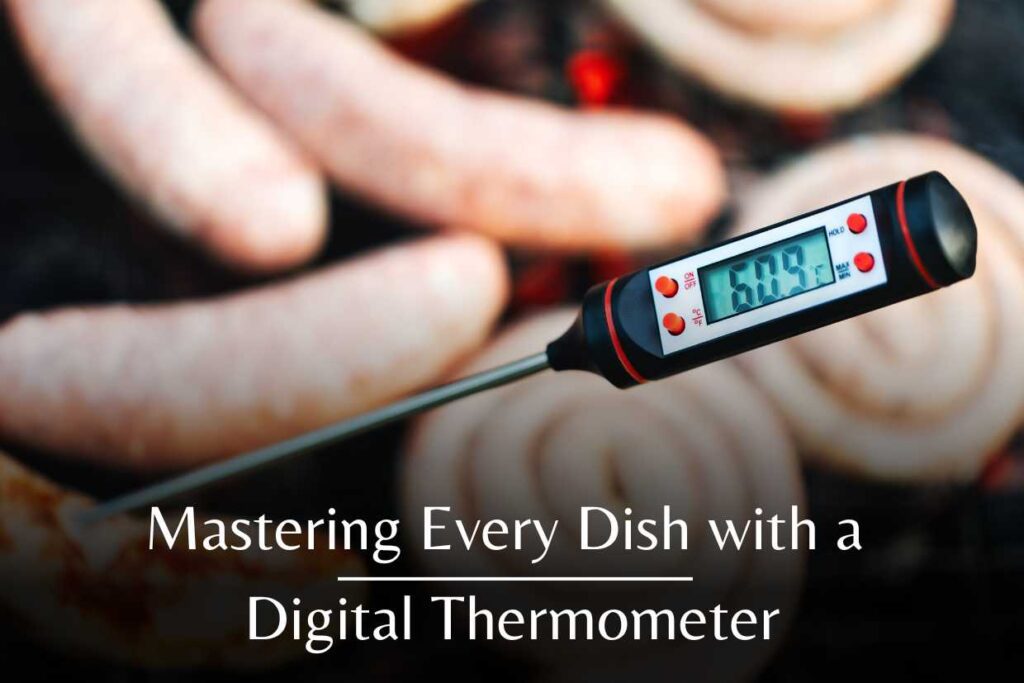Have you ever carefully measured the portions, mixed ingredients, and prepared but had a dry chicken breast that was as hard as a hockey puck steak? Or maybe you have felt the frustration of taking a bite and only being welcomed by a raw middle while the outside is well-cooked to a beautiful brown? If these horrors of the kitchen seem close to the bone, it is about time to learn about the Digital Thermometer as your winning ace.
You do not have to second-guess yourself any more about when to serve your delicious meal to guests because, with a Digital Thermometer, you are guaranteed to make a kill. No more hub-and-guessing, no more lame results—only that which must be flavourful and delicious to the taste.
A digital thermometer is quite an easy-to-use tool that helps people prepare dishes. It helps measure temperature so people cannot undercook or overcook the food. It goes without saying that the digital thermometer dispels the old-fashioned practices of poking, prodding or guessing the state of readiness of food in the oven.
A Digital Thermometer provides a reliable way of checking the temperature. It also ensures that the food you prepare is safe to eat since you can always ensure it has reached the recommended internal temperatures, thereby lowering the risks of food poisoning. How about getting a Digital Thermometer so you can be assured that what you’re preparing is also safe for your consumption?
Here it is, folks; fasten your seat belts and hold on tight while I am going to take you through a culinary revolution. Here in this extensive guide, you will find information on what Digital Thermometers are beneficial for, how to cook various meals, and many other special and helpful tips. It is time to prove to your friends, family, and even yourself that you can cook genuinely delicious meals that are served in restaurants in your own home with the help of a Digital Thermometer.
Why Use a Digital Thermometer?
Today’s Dynamic kitchen is incomplete without a Digital Thermometer because this is more than just a flair-up gizmo; it is an indispensable tool. Ranging from proper food safety management while preparing meals to obtaining standard measurements, a Digital Thermometer is one of the kitchen’s most useful tools.
Safety:Having a foodborne disease is one hell of a nightmare, and to avoid it, a Digital Thermometer is your best bet. Through internal temperature control, one will be sure that food has been properly cooked and that no bacteria is present in it. Do not go through another episode of food poisoning or have to go to the emergency room ever again. Have that calm feeling knowing you have a full stomach.
Consistency: Have you ever cooked the same dish at different times in the kitchen and noticed that it all turns out different? Say goodbye to those inconsistencies, which can easily be avoided thanks to the digital thermometer available. This useful device makes it possible to cook your food optimally, be it a piece of meat, a roast, or a cake. It can never go wrong.
Versatility: A digital thermometer is not just an instrument used for simply measuring internal temperature; it’s multi-function and can be used in different styles of cuisine and with different types of foods. A Digital Thermometer will do the job, from barbecuing steaks to baking bread to deep-frying chicken to roasting vegetables. Basically, it is like having your own sous-chef reminding you in your ear the correct temperature to cook every single food.
Ease of Use: Honestly, it is time to admit that using classic thermometers can be very challenging at times. They are primarily challenging to read and may require exotic holding, putting them into a place that may lead to burns or spills. Digital Thermometers, however, are pretty easy to use. These are modern technological miracles. Transparent digital displays and big buttons with readable temperatures help you cook your dishes without exhausting you or your wrist.
People Also Ask.
1. Do we really need to spend money on a digital thermometer?
In a world where everyone strives to create the best image of themselves and their lives, a Digital Thermometer is not only a bonus but also a need. While traditional methods such as poking and probing had been satisfactory for the ancients, it is something that today’s cooks should not settle for. A digital Thermometer helps in cooking by eliminating guesswork and observing the recommended temperatures for specific foods to avoid cases of foodborne illnesses. It is the perfect gadget that should grace every cook and kitchen.
2. What are the types of digital thermometers?
Similar to the various types of chefs, there are different kinds of Digital Thermometers that can suit the various cooking requisites. The two broad categories are probe thermometers, which are useful in regularly checking the temperature of food without the need to check often, and instant-read thermometers, which are useful in getting a quick and precise temperature of foods such as steaks and fish. But do not worry; we will explain each of the mentioned options in detail later on in this guide.
Mastering Different Dishes with a Digital Thermometer.

A Digital Thermometer is indeed the jack of all trades in the kitchen. It is a handy tool that can triumph over a myriad of meals and different ways of cooking. Whether it is a perfectly cooked steak with an equally crisp sear on the outer side or even a delicate, flaky fish fillet, Digital Thermometer is the gadget that will help you get those results in your own kitchen.
Meat is a delicate food that can be a real challenge to prepare since it is relatively easy to undercook or overcook. However, worrying about taking fevers can soon be a thing of the past if you have a Digital Thermometer by your side. To have soft and tender beef, you should get it done to an internal temperature of 145°F (63°C) for Medium Rare or 160°F (71°C) for well-done. The internal temperature of a pork dish should be 145 degrees F (63 degrees C). The chicken and turkey should be cooked to 165 degrees F (74 degrees C) to make sure that bacteria that cause illness are killed.
But what about eggs? The humble and rather underrated stars of the kitchen. Whether you want them soft, hardly done, or scrambled, there is a Digital Thermometer that will assist you get the right level of doneness. Soft-boiled eggs should be cooked to a temperature of 145°F (63°C), while hard-boiled eggs for that creamy yolk should be cooked to 71°C (160°F).
However, the miracle of a Digital Thermometer does not end here and can be your ace up your sleeve when it comes to baking. No more dry cakes or cakes that turn out to be overcooked or breads that are still raw inside. Internal temperature is an important factor that will help you achieve the desired level of doneness in your baked products leading to mouth-watering soft and fluffy baked products.
If you want to become a professional and prepare meals that simply melt in your mouth with the help of a Digital Thermometer, remember to properly insert it. When using the probe for the roasts and large parts of meat, place the probe into the thickest part of the piece of meat, but do not put the probe into the bones or fat. For fragile products such as chicken steaks or fish, calibrate an instant-read thermometer and insert the bulb in a miniature hole parallel to the flesh.
From grilling your favourite steak on the grill to deep frying your favourite chicken, a Digital Thermometer is the must-have kitchen gadget that will make your dishes perfect every time.
Choosing the Right Digital Thermometer.
Choosing the right Digital Thermometer might sound like a very herculean task, mainly because there is a proliferation of these products in the market. But do not worry, my friend. I will give you the basic directions that will assist you in choosing a Thermometer suitable for your kitchen.
The major considerations for a digital thermometer are accuracy and the range of temperatures it can read. Models with accuracy above ±1°F above or below or ±0.5°C above or below should be branded as accurate. Digital Thermometers can measure temperatures from -40F (-40C) to 450F (232C). If you plan to fry something in oil or bake it on a stove with the help of a wood fire, you might need the Digital Thermometer at a higher rate.
Another factor that should be taken into consideration is the kind of probe involved in the process. Digital Thermometers generally come in two varieties: probe thermometers and instant-read thermometers. You can leave a probe thermometer in the food, which is suitable for taking temperature readings throughout the cooking process, such as when you are slow-roasting a piece of meat or baking bread. These thermometers feature a probe that you insert into the food and a cable that connects to a base unit with a digital display, allowing you to monitor the temperature without constantly opening the oven or grill.
On the other hand, instant-read thermometers are built for quick temperature readings. These small and handy thermometers take only a few moments to give out the required temperature and are perfect for determining the quality of a seared steak, a flesh fish fillet, or a sautéed dish.
Although features are important, the interface should also be easy to use. Pay attention to the Digital Thermometers, which are preferably equipped with easy-to-read displays. User-friendly features like auto-shutoff and hold functions can also make your life easier in the kitchen.
Additional Tips and Tricks for Using a Digital Thermometer.

Having learned in detail how to properly choose a Digital Thermometer suitable for your needs, we move on to detailed tips and guidelines for making the most of this cooking instrument.
As with almost any kitchen utensil, cleaning and sanitation of this instrument are very important to avoid contamination of foods and to preserve the Digital Thermometer for a long time. For their use, it is recommended that the probe be washed with hot, soapy water and then dried before the next use. To be on the safe side, you can use a sanitizing solution to wipe the probe.
Even the most sophisticated instruments, such as Digital Thermometers, may gradually deteriorate, and their accuracy can decrease. However, calibration ensures that your temperature readings are always accurate.
Proper storage is important to continue getting the best from your Digital Thermometer. Do not place it in hot or cold conditions, and douse it with moisture and heat to ensure it is ready when required. If your thermometer comes with a protective case or sheath, do not fail to use it to protect the probe once it is not in use.
Conclusion.
As we come to the final part of our tour, it’s time to reflect on the transformative power of this unassuming culinary tool. Uncalculated risks, oversimplified disasters, and foodborne diseases are nowhere to be seen. With a digital food thermometer in your corner, you have all the cues and power to triumph over any delicacy that dares cross your path.
It is time for you to invest in a Digital Thermometer that will give you precise temperatures for the perfect meals. The only secret you’ll need is that unassuming yet powerful Digital Thermometer, your new best friend in the kitchen.





